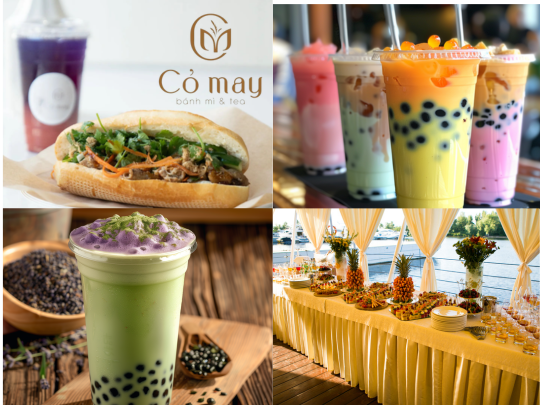Creating a Fusion Menu: Blending Foreign and British Culinary Traditions

Strong 8k brings an ultra-HD IPTV experience to your living room and your pocket.
How Foreign Restaurateurs Can Blend Their Native Culinary Traditions with British Tastes
Bringing a taste of your homeland to a new country can be an exciting yet challenging endeavor. As a foreign restaurateur in the UK, blending your native culinary traditions with British tastes can help you create a unique dining experience that appeals to a broad audience. Here's how you can achieve this delicate balance.
Understanding British Taste Preferences
To successfully blend culinary traditions, it's essential to understand the food preferences of your new customer base.
Common British Food Preferences
British cuisine often emphasizes hearty, comforting dishes. Traditional favorites include roast dinners, fish and chips, and hearty stews. There's also a growing appreciation for fresh, healthy ingredients and diverse global flavors.
Popular British Ingredients and Flavors
Popular ingredients include potatoes, carrots, peas, lamb, beef, and various seafood. Flavors tend to be savory and balanced, with an emphasis on herbs like rosemary, thyme, and mint.
Researching the Market
Analyzing Local Food Trends
Keep an eye on local food trends to see what's currently popular. Visit other restaurants, attend food festivals, and read local food blogs to get a sense of the evolving tastes in your area.
Understanding Customer Demographics
Understanding who your customers are is crucial. Are they families, young professionals, or retirees? Each group may have different preferences and spending habits, which can influence your menu offerings and marketing strategies.
Check: Steps by Step Guide to Open a Restaurant in the UK as a Foreigner by UK Business visa Consultant.
Creating a Fusion Menu
Combining Traditional and Local Ingredients
Start by identifying which of your native dishes can be adapted with local ingredients. This could mean using British meats in your traditional recipes or incorporating popular local vegetables.
Developing Signature Dishes
Create a few signature dishes that blend the best of both culinary worlds. These dishes should highlight unique flavors from your homeland while incorporating familiar elements to appeal to local tastes.
Maintaining Authenticity
Preserving the Essence of Native Cuisine
While adaptation is key, it's important not to lose the essence of your native cuisine. Keep the core flavors and cooking methods intact to maintain authenticity.
Balancing Authenticity with Adaptation
Find a balance between staying true to your culinary roots and making necessary adjustments for local palates. This might involve moderating spice levels or tweaking traditional recipes to suit British tastes.
Incorporating Seasonal and Local Produce
Benefits of Using Local Ingredients
Using local ingredients not only supports the community but also ensures freshness and sustainability. It can also make your dishes more relatable to local customers.
Adapting Recipes to Seasonal Availability
Adjust your menu seasonally to incorporate the freshest ingredients. This keeps your offerings fresh and exciting while allowing you to showcase the best local produce.
Adapting Cooking Techniques
Adjusting Traditional Techniques for Local Preferences
Consider adjusting cooking techniques to align with local preferences. For example, if deep-frying is common in your cuisine but less popular locally, you might explore baking or grilling alternatives.
Incorporating Modern Cooking Methods
Incorporate modern cooking methods and equipment to enhance the efficiency and appeal of your dishes. Sous-vide, for example, can help achieve perfect textures while preserving traditional flavors.
Engaging with Local Suppliers
Building Relationships with Local Producers
Forge strong relationships with local suppliers and farmers. This ensures a reliable supply of fresh ingredients and can lead to beneficial collaborations and cost savings.
Sourcing Quality Ingredients
Always prioritize quality when sourcing ingredients. High-quality ingredients can elevate your dishes and enhance the dining experience, making your restaurant stand out.
Staff Training and Education
Educating Staff on Cultural and Culinary Traditions
Ensure your staff understands the cultural significance and preparation methods of your dishes. This knowledge helps them communicate your restaurant's story and offerings to customers.
Implementing Staff Training Programs
Regular training programs can help your staff stay updated on new menu items and service techniques, ensuring they deliver a consistent and excellent dining experience.
Marketing Your Fusion Cuisine
Effective Marketing Strategies
Utilize a mix of traditional and digital marketing strategies. Flyers, local press releases, social media campaigns, and a strong online presence can attract a diverse customer base.
Utilizing Social Media and Local Media
Leverage social media platforms to showcase your dishes, share your culinary journey, and engage with customers. Collaborate with local influencers and food bloggers to expand your reach.
Check: Steps by Step Guide to Open a Restaurant in the UK as a Foreigner by UK Business visa Consultant.
Creating a Welcoming Ambiance
Designing an Inviting Restaurant Environment
Design your restaurant to reflect both your native culture and local tastes. This could involve blending traditional decor elements with modern, comfortable furnishings.
Blending Cultural Aesthetics with Local Preferences
Incorporate subtle cultural touches without overwhelming the space. Think of using traditional artwork elements, textiles, and color schemes that create a warm and inviting atmosphere, while ensuring the overall design aligns with local preferences for comfort and functionality.
Gathering and Responding to Feedback
Encouraging Customer Feedback
Actively seek feedback from your customers to understand their preferences and experiences. Use comment cards, online surveys, and social media to gather insights.
Using Feedback to Improve Your Offerings
Use the feedback to make informed decisions about menu adjustments, service improvements, and other operational changes. Showing customers that you value their opinions can build loyalty and trust.
Collaborating with the Community
Participating in Local Food Events
Get involved in local food festivals, farmers' markets, and community events. These venues offer excellent opportunities to showcase your cuisine and connect with potential customers.
Partnering with Other Local Businesses
Form partnerships with local businesses to create mutually beneficial promotions. For example, collaborate with local breweries or dessert shops to offer combined specials or joint events.
Celebrating Cultural Festivals
Hosting Events for Cultural Celebrations
Organize events around cultural festivals from your homeland. This not only introduces your customers to your traditions but also creates a festive and memorable dining experience.
Offering Special Menus During Festivals
Create special menus for these occasions featuring traditional dishes that are popular during your cultural festivals. This can attract both existing customers and new ones curious about different culinary traditions.
Conclusion
Blending your native culinary traditions with British tastes can create a unique and successful dining experience. By understanding local preferences, adapting your recipes and techniques, engaging with the community, and maintaining authenticity, you can carve out a niche in the UK restaurant scene. Remember, the key is to find a balance between introducing new flavors and honoring the familiar tastes that locals love.
The SmartMove2UK’s Success Story: Mr. Roop Pratap Chaudhury recently started a new restaurant, Colonel Saab, in London, and was assisted in the process by Mrs. Falguni Y Parekh, a UK Immigration Solicitor and Founder of The SmartMove2UK.
FAQs
How can I make my native dishes more appealing to British customers?
To make your native dishes more appealing, start by incorporating familiar British ingredients and flavors. Adjust seasoning levels to suit local palates, and consider offering a fusion menu that blends the best of both culinary traditions.
What are some effective ways to market my fusion cuisine?
Utilize a combination of social media, local advertising, and partnerships with local businesses. Engage with food bloggers and influencers to reach a wider audience. Hosting events and participating in local food festivals can also boost your restaurant's visibility.
How do I balance authenticity with local tastes?
Maintain the core flavors and cooking methods of your native cuisine while making slight adjustments to suit local preferences. This could involve moderating spice levels or incorporating popular local ingredients.
What are the benefits of using local ingredients?
Using local ingredients supports the community, ensures freshness, and can make your dishes more relatable to local customers. It also allows you to adapt your menu seasonally, showcasing the best produce available.
How can I gather useful feedback from my customers?
Encourage feedback through comment cards, online surveys, and social media. Engage with your customers directly and listen to their suggestions and concerns. Use this feedback to make informed improvements to your menu and service.
Note: IndiBlogHub features both user-submitted and editorial content. We do not verify third-party contributions. Read our Disclaimer and Privacy Policyfor details.







